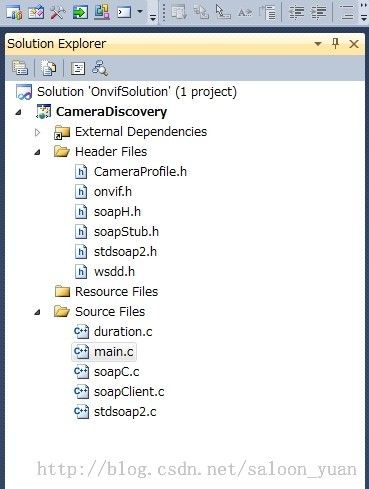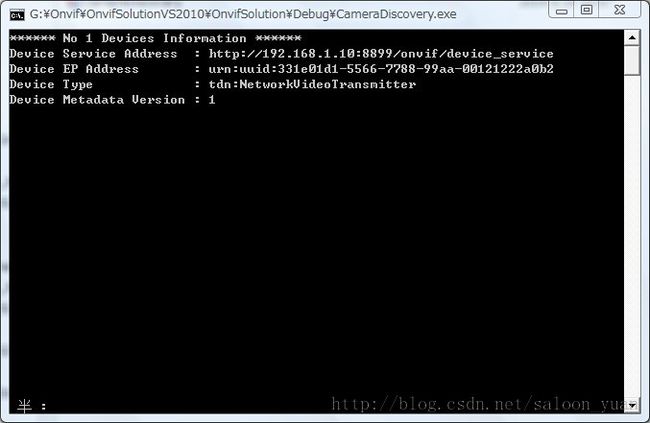Onvif备忘录(2)----客户端端设备发现
续上篇,框架代码生成之后,就可以进行基于Onvif的开发了,先实现一个简单的设备发现的例子。 VisualStudio中新建一个空白工程,将上篇中生成的框架代码添加进来,但soapServer.c文件中定义了许多要实现的函数,直接添加编译会报一大堆错误,且本例中只需要用到Client的功能,so 。。。 删掉soapServer.c, 留下soapClient.c即可。
Onvif相机接上路由器,运行程序之后,成功检测到该Camera,详细信息如下图:(整个工程已经上传,需要的请狂点 我的资源下载)
工程结构如下:
main.c代码如下:
- #include "wsdd.h"
- #include <stdio.h>
- static struct soap* ONVIF_Initsoap(struct SOAP_ENV__Header *header, const char *was_To, const char *was_Action, int timeout)
- {
- struct soap *soap = NULL;
- unsigned char macaddr[6];
- char _HwId[1024];
- unsigned int Flagrand;
- soap = soap_new();
- if(soap == NULL)
- {
- printf("[%d]soap = NULL\n", __LINE__);
- return NULL;
- }
- soap_set_namespaces( soap, namespaces);
- if (timeout > 0)
- {
- soap->recv_timeout = timeout;
- soap->send_timeout = timeout;
- soap->connect_timeout = timeout;
- }
- else
- {
- //Maximum wait time: 20S
- soap->recv_timeout = 20;
- soap->send_timeout = 20;
- soap->connect_timeout = 20;
- }
- soap_default_SOAP_ENV__Header(soap, header);
- // Create SessionID randomly
- srand((int)time(0));
- Flagrand = rand()%9000 + 8888;
- macaddr[0] = 0x1; macaddr[1] = 0x2; macaddr[2] = 0x3; macaddr[3] = 0x4; macaddr[4] = 0x5; macaddr[5] = 0x6;
- sprintf(_HwId,"urn:uuid:%ud68a-1dd2-11b2-a105-%02X%02X%02X%02X%02X%02X",
- Flagrand, macaddr[0], macaddr[1], macaddr[2], macaddr[3], macaddr[4], macaddr[5]);
- header->wsa__MessageID =(char *)malloc( 100);
- memset(header->wsa__MessageID, 0, 100);
- strncpy(header->wsa__MessageID, _HwId, strlen(_HwId));
- if (was_Action != NULL)
- {
- header->wsa__Action =(char *)malloc(1024);
- memset(header->wsa__Action, '\0', 1024);
- strncpy(header->wsa__Action, was_Action, 1024);//"http://schemas.xmlsoap.org/ws/2005/04/discovery/Probe";
- }
- if (was_To != NULL)
- {
- header->wsa__To =(char *)malloc(1024);
- memset(header->wsa__To, '\0', 1024);
- strncpy(header->wsa__To, was_To, 1024);//"urn:schemas-xmlsoap-org:ws:2005:04:discovery";
- }
- soap->header = header;
- return soap;
- }
- int ONVIF_ClientDiscovery( )
- {
- int FoundDevNo = 0;
- int retval = SOAP_OK;
- wsdd__ProbeType req;
- struct __wsdd__ProbeMatches resp;
- wsdd__ScopesType sScope;
- struct SOAP_ENV__Header header;
- struct soap* soap;
- const char *was_To = "urn:schemas-xmlsoap-org:ws:2005:04:discovery";
- const char *was_Action = "http://schemas.xmlsoap.org/ws/2005/04/discovery/Probe";
- //IP Adress and PortNo, broadCast
- const char *soap_endpoint = "soap.udp://239.255.255.250:3702/";
- //Create new soap object with info
- soap = ONVIF_Initsoap(&header, was_To, was_Action, 10);
- soap_default_SOAP_ENV__Header(soap, &header);
- soap->header = &header;
- soap_default_wsdd__ScopesType(soap, &sScope);
- sScope.__item = "";
- soap_default_wsdd__ProbeType(soap, &req);
- req.Scopes = &sScope;
- req.Types = ""; //"dn:NetworkVideoTransmitter";
- //sent the message broadcast and wait
- retval = soap_send___wsdd__Probe(soap, soap_endpoint, NULL, &req);
- while (retval == SOAP_OK)
- {
- retval = soap_recv___wsdd__ProbeMatches(soap, &resp);
- if (retval == SOAP_OK)
- {
- if (soap->error)
- {
- printf("[%d]: recv soap error :%d, %s, %s\n", __LINE__, soap->error, *soap_faultcode(soap), *soap_faultstring(soap));
- retval = soap->error;
- }
- else //we find a device
- {
- FoundDevNo ++;
- if (resp.wsdd__ProbeMatches->ProbeMatch != NULL && resp.wsdd__ProbeMatches->ProbeMatch->XAddrs != NULL)
- {
- printf("****** No %d Devices Information ******\n", FoundDevNo );
- printf("Device Service Address : %s\r\n", resp.wsdd__ProbeMatches->ProbeMatch->XAddrs);
- printf("Device EP Address : %s\r\n", resp.wsdd__ProbeMatches->ProbeMatch->wsa__EndpointReference.Address);
- printf("Device Type : %s\r\n", resp.wsdd__ProbeMatches->ProbeMatch->Types);
- printf("Device Metadata Version : %d\r\n", resp.wsdd__ProbeMatches->ProbeMatch->MetadataVersion);
- //sleep(1);
- }
- }
- }
- else if (soap->error)
- {
- if (FoundDevNo == 0)
- {
- printf("No Device found!\n");
- retval = soap->error;
- }
- else
- {
- printf("Search end! Find %d Device! \n", FoundDevNo);
- retval = 0;
- }
- break;
- }
- }
- soap_destroy(soap);
- soap_end(soap);
- soap_free(soap);
- return retval;
- }
- int main(void )
- {
- if (ONVIF_ClientDiscovery() != 0 )
- {
- printf("discovery failed!\n");
- return -1;
- }
- return 0;
- }
Onvif相机接上路由器,运行程序之后,成功检测到该Camera,详细信息如下图:(整个工程已经上传,需要的请狂点 我的资源下载)
转自:http://blog.csdn.net/saloon_yuan/article/details/27524875

